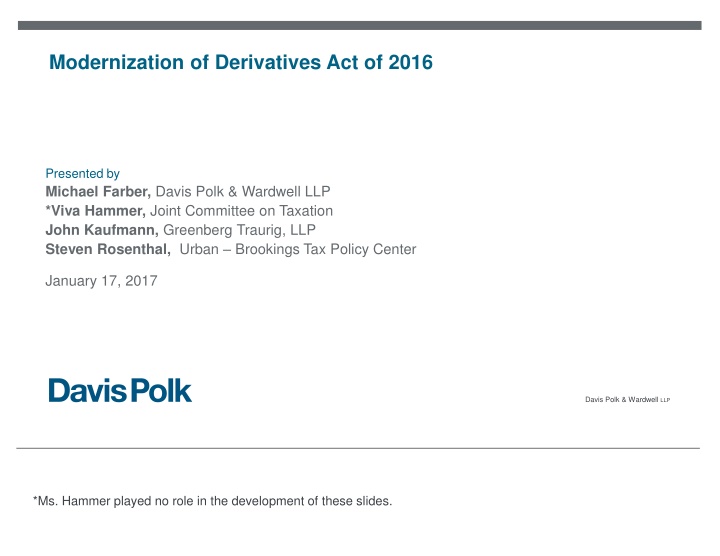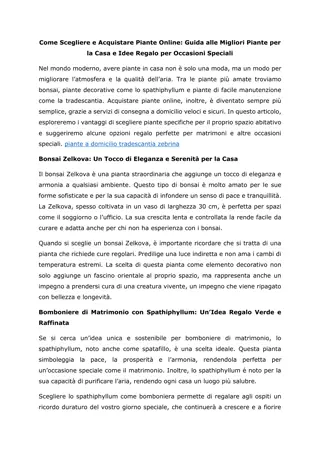
Modernization of Derivatives Act 2016
Explore the history, definition, and exceptions of derivatives under the Modernization of Derivatives Act of 2016. Learn about the bipartisan support for reform, the general rules of bifurcation, and exceptions to derivative classification. Dive into the complexities of derivative contracts and their valuation in the financial market.
Download Presentation

Please find below an Image/Link to download the presentation.
The content on the website is provided AS IS for your information and personal use only. It may not be sold, licensed, or shared on other websites without obtaining consent from the author. If you encounter any issues during the download, it is possible that the publisher has removed the file from their server.
You are allowed to download the files provided on this website for personal or commercial use, subject to the condition that they are used lawfully. All files are the property of their respective owners.
The content on the website is provided AS IS for your information and personal use only. It may not be sold, licensed, or shared on other websites without obtaining consent from the author.
E N D
Presentation Transcript
Modernization of Derivatives Act of 2016 Presented by Michael Farber, Davis Polk & Wardwell LLP *Viva Hammer, Joint Committee on Taxation John Kaufmann, Greenberg Traurig, LLP Steven Rosenthal, Urban Brookings Tax Policy Center January 17, 2017 Davis Polk & Wardwell LLP *Ms. Hammer played no role in the development of these slides.
History There is long-term, bipartisan and bicameral support for the reform of the taxation of derivatives: In early 2016, the Senate Finance Committee ranking minority member Senator Ron Wyden (D-OR) released a discussion draft, the Modernization of Derivatives Tax Act ( MODA ) This was similar to a proposal made in 2013 by David Camp (R-MI), then head of the House Ways & Means Committee Both proposals would require that derivatives and certain hedged positions be marked to market Both proposals would repeal various current provisions applicable to derivatives and items hedged thereby 2
Definition of Derivative Any contract (including any option, forward contract, futures contract, short position, swap, or similar contract) the value of which, or any payment or other transfer with respect to which, is (directly or indirectly) determined by reference to any of the following (each an underlying investment, which need not be publicly traded): A share of stock; A partnership or beneficial ownership interest in a partnership or trust; An evidence of indebtedness; Real property (with important exceptions); An actively traded commodity; A currency; A rate, price, amount, index, formula, or algorithm; or Any other item the Secretary may prescribe 3
Bifurcation General Rule: Embedded derivatives are marked. If an embedded derivative can not be separately valued, both the embedded derivative and the host derivative are marked Exception: FX denominated bonds need not be bifurcated Everything can be bifurcated. When do you stop? Is a convertible bond automatically bifurcated into an option and a debt? Appears so Is a floating rate bond bifurcated into rate bond and a fixed-for-floating swap? Is a fixed rate bond bifurcated into a zero-coupon bond and an interest rate derivative? Would regulations Sections 1.1275-4 (CPDIs) and 1.1275-5 (VRDIs) continue to be necessary? 4
Derivative Exceptions The following are excepted from the definition of derivative: Physically settled contracts with respect to real property; ADRs and ADSs; Contracts that are part of a business hedging transaction or certain FX hedging transactions; To the extent provided by the Service, securities lending, sale-repurchase or similar transactions; An option described in Section 83(e)(3) received in connection with the performance of services; Insurance contracts, annuities, and endowment contracts; A derivative (determined without regard to MODA) with respect to stock issued by any member of the affiliated group of which the taxpayer is a member; and A contract with respect to a commodity used in the normal course of the taxpayer s trade or business that requires physical settlement. 5
Operating Rules Naked Derivatives Timing: Gain or loss is recognized upon the occurrence of (i) taxable year-end and (ii) any termination or transfer, regardless of whether it would cause gain or loss recognition under current law Amount of gain or loss: In the event of termination, transfer or sale, gain or loss is calculated under ordinary tax principles; In the absence of a termination, transfer, or sale, value may be determined by applicable financial statements or broker report. Character: Ordinary Source: Residence of recipient, with an exception for Section 871(m) dividend equivalents Payments pursuant to the contract:i.e., those that do not constitute a taxable event, are taken into account when made ( other than an option [payment] ). Proper adjustment is made to subsequent gain or loss to account for prior payments 6
Definition of an IHU One or more derivatives and an underlying investment with respect thereto, so long as the derivative(s) has/have a delta of -0.7 or less with respect to the underlying investment Delta: The ratio of the expected change in the fair market value of a derivative to a change in the fair market value of its underlying instrument Attribution: Positions held by persons related to a taxpayer are treated as held by the taxpayer (spouses or consolidated return members) Election: Taxpayers may elect to treat all derivatives and underlying investments with respect thereto as an IHU, regardless of delta. This eliminates the need for delta testing. The election applies to all portions of the underlying investment and all derivatives with respect thereto, and is irrevocable 7
Identification of an IHU Taxpayers are required to test for delta, and to identify IHUs Timing: Taxpayers must test positions for IHU status at the following times: When the taxpayer first holds positions in an underlying investment and a derivative or derivatives with respect thereto and When the taxpayer adjusts any of the positions. Manner: Derivatives and underlying positions in an IHU must be tested in a manner that clearly identifies them as such. This appears to be a books- and-records identification Failure to Identify: Taxpayers who fail to test for delta and identify positions as IHU components are deemed to have made the IHU regardless of delta election Incorrect Identification: Consequences to be determined by regulation 8
Operating Rules IHUs Entering into an IHU Pre-IHU gain is recognized when positions are acquired that constitute an IHU Built-in loss (i.e., pre-IHU loss) is not recognized when an offsetting IHU leg is entered into. This loss is recognized when the property is disposed of or terminated or transferred. Holding period of underlying investment is reset upon entry MTM Gain or loss with respect to all legs of an IHU are marked to market General Rule: Account for marks at year end Regardless-of-Delta Electors: Taxpayers who make the regardless-of-delta election must account for marks daily (query relevance, given annual tax accounting) Adjustments: Gain and IHU-period loss are recognized with respect to every component of an IHU when any leg of the IHU is adjusted, added to or subtracted from Pre- IHU Built-in Loss is recognized when that particular position is terminated or transferred 9
Delta Limitation: Delta can not be calculated for certain derivatives, as the evolution of Section 871(m) has demonstrated This might in theory be soluble with better disaggregation and combination rules, but query whether administrable rules can be written Definition: In option pricing, delta denotes the correlation between an option and the option s legal referent. However, it appears that the term is intended simply to mean correlation in the context of MODA Rates, indices and formulas are referred to as potential underlying investments. However, it is impossible to own intangibles of this type. Therefore, the only way that this reference can be meaningful is for a derivative and an underlying investment both to correlate with the same rate, index or formula Note that this is not what the legislation as drafted says 10
Delta Indirect Reference Example 1: Taxpayer purchases shares in an oil company and shorts a corresponding notional amount of oil futures contracts. The value of the shares correlates with that of the oil futures contracts. This is because both are affected by the price of oil Under current law, the futures contracts are not derivatives with respect to the shares, because they do not refer to the shares. 475(c)(2)(E); 1234A(1); Treas. Reg. Section 1.871- 15(g)(1); Prop. Reg. Section 1.864(b)-1(b)(2)(ii) However, the shares and the futures contracts may constitute a straddle, if the short futures position substantially diminishes the taxpayer s risk of loss with respect to the shares, and the shares and the futures contract primarily reflect the performance of a single economic factor. Treas. Regs. 1.1092(d)-2(a), 1.246-5(b)(1) and (d), ex. 2 Under MODA, the futures contracts may be treated as derivatives with respect to the shares, because the value of the futures contracts may be treated as determined indirectly by reference to the value of the shares. This is not a natural reading of the language of the legislation, however 11
Indirect Reference (contd) Example 2: Taxpayer purchases a portfolio of bonds issued by ABC corp, a highly rated investment-grade domestic corporation. At the same time, the taxpayer purchases credit protection on an equivalent principal amount of bonds issued by ABC corp under a credit default swap. The terms of the swap do not reference any particular bond issued by ABC corp, but do reference all bonds pari passu with the purchased bonds Alternatively, instead of purchasing a single-name credit default swap, taxpayer purchases protection on a broad index of domestic investment-grade issuers Note that the primarily reflect the performance rules of Section 1.246-5 do not apply to non- stock straddles; as to those, there is no specific controlling law Example 3: Taxpayer purchases SPY (a RIC) and enters into short VIX futures. VIX futures refer to the volatility of the S&P 500 contract, rather than the price thereof, and do not refer to SPY. However, SPY and VIX are negatively correlated. Could this be an IHU? 12
Identification Problems Unbalanced Hedges: Taxpayer buys 1,000 shares of ABC, and buys 7 ABC puts with a delta of -0.875 each. There is clearly an IHU but what is the IHU? 700 shares and 7 puts (-0.875 delta)? 800 shares and 7 puts (-0.766 delta)? 850 shares and 7 puts (-0.7 delta)? Portfolio Hedges:If more than one investment in a taxpayer s portfolio correlates with a derivative, which underlying investment should be included in the IHU? Non-controlled Partnerships: Minority members may not even know what positions are held by a non-controlled partnership 13
Marking IHUs on Entry General Rule: Heads, I win; tails, you lose: gains recognized on entry but losses suspended until disposition of the relevant position Character: Why is gain on a capital asset that becomes part of an IHU ordinary? It would be capital if the position were sold and re-acquired This is an uneconomic and non-policy-driven trap for the unwary Exacerbated significantly by the difficulty of identifying IHU components and the consequences of failing to do so properly Built-in Losses on Derivatives: Built-in losses on derivatives that become part of an IHU are suspended until the derivative is terminated or transferred This does not make sense the loss would be marked at year end if the taxpayer simply continued to hold the derivative naked Again, an uneconomic trap for the unwary Holding Period: Holding period in underlying investments is reset to zero This creates the opportunity to convert long-term capital loss into short-term capital loss 14
Problem with non-IHU Mixed Straddles Taxpayer holds one or more derivatives and an underlying which constitute offsetting positions with respect to personal property, but which do not constitute an IHU (delta > -0.7) Timing Mismatch: The derivative will be marked, but the underlying will be accounted for on a realization basis; losses on the derivative will be deferred to the extent of built-in gains in the cash position, but gains on the derivative will be recognized currently Character Mismatch: Gain or loss on the derivative will be ordinary; gain or loss on cash position will be capital. QCC Repeal: QCCs have deltas > -0.7. Repealing the QCC exemption from the straddle rules would exacerbate the non-IHU mixed straddle problem significantly Well advised taxpayers will simply be forced to make the IHU election; other taxpayers will tend to suffer significant uneconomically adverse consequences 15
Payments on Derivatives General Rules Payments made pursuant to a derivative, other than pursuant to a taxable event, are taken into account at the time of payment, and proper adjustment is made to subsequent gain or loss Character: presumably ordinary Adjustment: Payment will likely affect valuation in any event. What adjustment is needed? Issues Collateral:Is posting collateral a payment ? 305: If an adjustment that merely preserves value is a dividend, is the corresponding basis deductible on the ensuing mark? If so, why bother? FIRPTA: FIRPTA treats certain amounts of gain as effectively connected income. Does ordinary foreign-sourcing change this result? Proposed PFIC Option Rules Treat certain dividends and gains as subject to special rules. Do those rules to apply to marks? 1032 Does the regime override Section 1032? It appears to, as it requires gain/loss to be recognized on taxable events without regard to any nonrecognition provisions 16
Payments on Derivatives (Contd) Options and Short Sales: Cash received (paid, in the case of a long option) on Day 1 is offset by an equal and opposite obligation (right, in the case of a long option). As an economic matter, these up-front payments should not be taken into account on Day 1 Proper MTM Accounting: Valuing the difference between cash received (paid) on day 1 and the obligation assumed (right received) on a valuation date reflects economic gain or loss as of the valuation date MODA Treatment: The foregoing is intuitively correct, but not explicit in MODA Option Premium:Payments on derivatives other than . . . an option must be taken into account at time of payment. This seems to indicate that options should be accounted for as described above Definition of Option :Many instruments not labeled options have option economics (e.g., swaptions, cash-settled options on indices or rates, caps, floors). Unclear whether these are options under MODA Short Sale proceeds prepayments on forward contracts should be accounted for in the same way as option premia, but are not mentioned 17
Non-Portfolio Derivatives Definition of derivative covers rights to purchase Target stock in an acquisition (so long as Target is not a member of a worldwide affiliated group, per Section 864(f) Repeal of Section 1234A appears at odds with ILM 201642035 and FAA 20163701F (loss due to fees paid with respect to failed merger treated as capital loss to the extent that Target s stock would have been capital asset in Taxpayer s hands, per Section 1234A) 18
Sourcing Rule Gain or loss is sourced by reference to the residence of the taxpayer No mention of whether gain or loss attributable to a non-residence-jurisdiction-based PE or QBU of a taxpayer is sourced by reference to the residence of the taxpayer or the PE/QBU In the case of positions held by partnerships, is source determined at the level of the partner, or at the level of the partnership? 19
Basis Basis adjustments for marks are not mentioned in the proposal How will basis or proceeds be reported by brokers under 6045, if there are no basis adjustments for marks? How will derivative basis be counted in regimes that rely on basis (e.g., 357(b), 361(c)?) 20
Dealer Rules MODA provides that derivatives are not securities for purposes of Section 475(c) However, Section 475 continues to apply to the underlying securities, even in what would be an IHU If so, if a dealer has a security and an offsetting derivative and has identified the positions as held for investment, the IHU rules will not apply No triggering of built-in gains (1259 repealed), but presumably a mixed straddle; both inappropriate results 21






